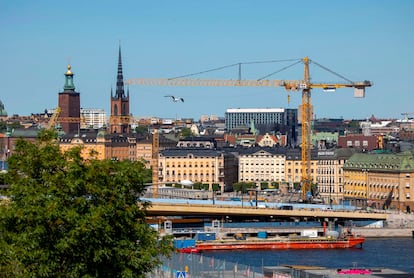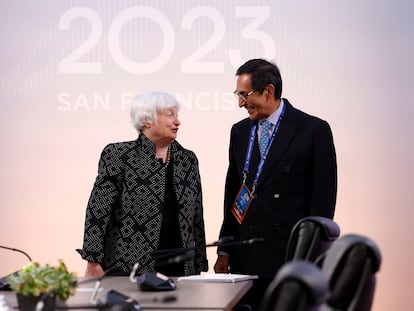Sweden’s housing market teeters on the edge: Is another bubble about to burst?
The sector grew fast on the heels of cheap credit, but rising interest rates are taking their toll on the country’s heavily indebted households

Ilija Batljan is the founder of a company with a difficult-to-pronounce name: Samhallsbyggnadsbolaget I Norden AB, which translates from Swedish to English as Social Building Company, a real estate fund better known for its acronym SBB. Batljan was born in Montenegro and emigrated to Sweden in the 1990s, during the Balkan Wars. There, in the Scandinavian nation, he graduated with a degree in economics and a PhD in demography and elderly care planning. He then embarked on a successful political career under the banner of the Swedish Social Democratic Party. After serving as mayor of a small town in the province of Stockholm, he left it all behind in 2011 to work for a real estate company. The company fired him, but Batljan had already come to realize that his future was in that sector, and in 2016, he started SBB with a big and risky goal: to pursue real estate investments in health centers, nursing homes, public schools and even police stations, and then to lease those facilities to local governments.
His gamble paid off. In less than a decade, brick by brick, he had built up a business portfolio valued at $13 billion. Most of the company’s investments are in social housing and municipal properties across the Nordic region, which it obtained thanks to a wave of cheap loans. By the end of 2021, SBB had some 60 million square meters in real estate property, equivalent to 20 Empire State Buildings. Today, however, SBB has become the symbol of an industry that is faltering in the face of sharply rising mortgage prices (driven by rising rates, which have also dragged down the currency value), compounded by runaway inflation (which peaked last December at 12.3%, the highest in more than 30 years) and high household indebtedness. After reaching an all-time high in the second quarter of 2022, home prices began to fall. “Since then, they’ve fallen by around 12%, which means that, in real terms, they’ve fallen by more than 20%,” says Andrew Kenningham, chief economist at Capital Economics, a London-based research firm.
“There has been a significant course correction,” notes Daniel Kral, a senior economist at Oxford Economics. But the situation, analysts claim, does not constitute a bursting bubble. “Although we could see a further decline in the coming months, prices will ultimately return to the same level as in 2020,” explains Jens Magnusson, chief economist at SEB (Skandinaviska Enskilda Banken AB, a Northern European financial group). The situation is still concerning, however, due to high levels of family indebtedness. In Sweden (population 10.8 million), owning a home has almost always been easier than renting, and mortgage debt accounts for 83% of all household debt, according to the country’s financial supervisor. Swedes are twice as indebted as Germans or Italians. And real estate accounts for 18% of bank loans, which is three times more than in Spain, according to the Organization for Economic Cooperation and Development (OECD).
Housing prices and indebtedness rose following the last financial crisis, in response to the fall in interest rates. For a period of nearly five years — from February 2015 to the end of 2019 — loan rates were in the negative. Today, they are at 4%, which has incentivized people to secure property while the economy is buoyant. Between 2008 and 2021, Sweden’s average annual GDP growth was 1.7% (double that of the EU as a whole). The Nordic model was praised and its politicians stuck out their chests whenever they could. Deep down, however, problems were brewing. “A structural imbalance was emerging,” says Kral. On the demand side, population growth and ultra-low interest rates were not adequately offset by the availability of real estate. Prices then began to rise, exacerbated by the high yields enjoyed by home-flipping businesses. “The Swedish market has gone through a classic boom-and-bust cycle over the past 15 years,” Kenningham says. “Prices doubled between 2007 and 2022, making it the largest increase among most advanced economies.”
The picture is even cloudier when looking at financial commitments among households. On average, household debt is approximately 195% of disposable income (after taxes). This indicator is cause for concern, especially as interest rates on that debt rise. And in a context where the majority of mortgages (between 60% and 70%) have been signed with a variable rate. “The combination of large household debt and variable loans has made Swedish households and the economy more sensitive to monetary policy decisions,” stresses SEB’s chief economist. “Not that I’m particularly concerned that households will not be able to repay their loans, but it could significantly reduce other spending, which in turn will contribute to the economic slowdown,” he says. According to forecasts, Sweden will be the only economy in Europe to fall into recession at the end of this year.
Domino effect
The weak housing market is already taking its toll on the construction sector and, together with increased uncertainty and higher costs, is driving down investment. “In a good year, we see around 75,000 new housing starts. This year, we’ll be lucky if we see 25,000,” says Magnusson.
Sweden, a country that has had a controlled rental market since the late 1940s but where you have to wait, on average, about 9.2 years to secure a dwelling through the scheme, knows what a housing crisis looks like. In the early 1990s, after the removal of strict mortgage limits, the market crashed, triggering a major crisis that led to the nationalization of two banks, the bailout of a third (with losses equivalent to 12% of GDP) and the devaluation of the krona. It took almost four years for the country to recover from the shock. At the time, Ilija Batljan, the founder of SBB, had just landed on Scandinavian soil and had no idea what fate would have in store for him three decades later. He probably never would have imagined becoming what he is today, nor the size of the billion-dollar business he has managed to build, whose credit rating has now been downgraded to junk-bond status, forcing him to step down from his position as CEO. But to Caesar what belongs to Caesar: Batljan still retains 8.3% of the company’s shares and nearly 32% of its votes on the board of directors.
Sign up for our weekly newsletter to get more English-language news coverage from EL PAÍS USA Edition
Tu suscripción se está usando en otro dispositivo
¿Quieres añadir otro usuario a tu suscripción?
Si continúas leyendo en este dispositivo, no se podrá leer en el otro.
FlechaTu suscripción se está usando en otro dispositivo y solo puedes acceder a EL PAÍS desde un dispositivo a la vez.
Si quieres compartir tu cuenta, cambia tu suscripción a la modalidad Premium, así podrás añadir otro usuario. Cada uno accederá con su propia cuenta de email, lo que os permitirá personalizar vuestra experiencia en EL PAÍS.
¿Tienes una suscripción de empresa? Accede aquí para contratar más cuentas.
En el caso de no saber quién está usando tu cuenta, te recomendamos cambiar tu contraseña aquí.
Si decides continuar compartiendo tu cuenta, este mensaje se mostrará en tu dispositivo y en el de la otra persona que está usando tu cuenta de forma indefinida, afectando a tu experiencia de lectura. Puedes consultar aquí los términos y condiciones de la suscripción digital.
More information
Últimas noticias
Chris Martin, Taylor Swift, Elijah Wood and other famous wedding ‘crashers’
‘How does it feel to be a failure?’: Elizabeth Berkley’s journey from ‘Showgirls’ ridicule to vindication
The story of the Málaga virus: The code that haunted Google’s cybersecurity center director for 30 years
The impact of Ecuador’s mega-prison: A polluted river, cleared forests and military checkpoints
Most viewed
- Christian Louboutin: ‘Young people don’t want to be like their parents. And if their parents wear sneakers, they’re going to look for something else’
- The low-cost creative revolution: How technology is making art accessible to everyone
- Liset Menéndez de la Prida, neuroscientist: ‘It’s not normal to constantly seek pleasure; it’s important to be bored, to be calm’
- All the effects of gentrification in one corner of Mexico’s Colonia Roma
- December Social Security and SSI payments: Dates, double checks and the 2026 COLA increase











































